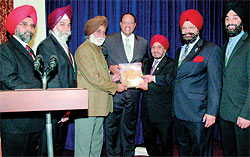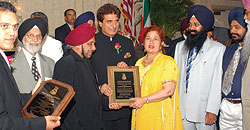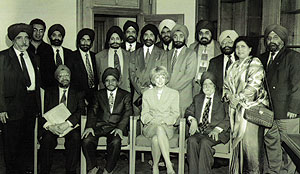|
Darshan Singh Bagga came to New York with an electric engineering degree in 1970, at a time when Sikhs were not visible on the roads in the East Coast region—their miniscule presence as doctors was confined to hospitals. Yet, he got his first residential accommodation and first professional break because of his unique appearance—turban and unshorn head and facial hair. “I was destined to achieve unprecedented success because I was a turban wearing proud Sikh,” he says.
While moving up in his profession, he realized that he may not go beyond the supervisor position, but he had already started a side business as general contractor. In 1981, he bought a 96-apartment building in partnership and a 2 acre plot of land in Old Brookville, Long Island, over which he built his palatial house in 1983. He was perhaps the first Indian who built as a general contractor in this posh area.
 |
Celebration of Guru Nanak Dev Ji’s Birthday for the first time at the White House. Mr Bagga (third from left) presents a plaque to a representative of President Barack Obama on behalf of the Sikh community |
|
|
 |
Mr DS Bagga receiving Punjab Rattan Award at WPO Gala from Raj Babbar - Member of Indian Parliament |
|
|
 |
Celebration of Khalsa Tricentennial Birthday at New York State Assembly, Albany on April 1999. Mr Bagga (seated, second from left) is seated next to the Lieutenant Governor (third from left) |
|
|
In 1986, he acquired a single-storey shopping centre in New York, at higher than asked for price despite the depressed economy. He had a vision and being an engineer he calculated that he could build nine extra stories above it. It became possible because, one, he manoeuvred the construction to let the shops continue to run, allowing uninterrupted cash flow. Two, he sponsored an amendment to New York tax abatements law, allowing tax exemption for adding storeys to an existing structure. The 10-floor Bagga Tower displaying the Sikh symbol of khanda was inaugurated in 1999 on the day of Khalsa Tricentenary. Due to the tax abatement amendment, hundreds of thousands of people have benefited from this amendment.
The second telling case of his vision is Bagga Plaza in the posh Woodbury-Syosset area in Long Island. In 2002 he purchased a very expensive 6-acre mall, which was lying vacant for three years. Leading developers had tried to develop it but had lost money. Mr Bagga bought this property and developed it from 45000 sq ft to 100,000 sq ft. He rented this Bagga Plaza to prestigious stores such as Marshalls, Home Goods and Petco. He named this mall as Bagga Plaza with the khanda. Today in Nassau County, Bagga Plaza is a prestigious address. Politicians and all concerned went on to compliment him for it, saying, “What you did was great”. The Asian American Society in 2006 honoured him as a “Visionary Developer of the Year” for his unique work.
He is currently building a 30,000 sq ft Bagga Complex in Hicksville and developing a 12-1/2 acre Bagga Estate in Mutton town, New York. He adds Bagga to the names of all his buildings to project the identity of the Sikh community. He argues that, “If there can be Trump Tower and Trump Plaza, then surely there can also be Bagga Plaza, Bagga Tower and Bagga Complex, Bagga Estate. Trump inherited properties worth a million dollars, but I came from India with $70 in my pocket.”
It is because of the foundation laid by people like Bagga that the Indian community’s influence in the wealthy Nassau County is of the same level as Jews in America. Today no politician of the county can think of succeeding without the Indian community’s support.
Because Sikhs have a unique look, Mr Bagga thought of making Americans aware of the principles of Sikhism, a religion from India, and distinguish it from Hinduism and Islam which they knew of.
Being an executive member he decided best to have a Sikh temple. So he helped establish the first Gurudwara in 1972 in Richmond Hill, New York. But the committee being mixed, at the next Gurudwara – Sikh Center in Flushing – established in 1973, with Bagga as Founder President, turban and unshorn hair were made mandatory for the management. These gurudwaras also helped Sikhs and other engineers get accommodation and jobs.
This was the first executive committee on the East Coast. The gurdwaras became a platform to tell people about Sikhism. Bagga recalls, “In gurdwaras we would invite American politicians and other Americans and explain that we are Sikhs and Guru Nanak was the first guru who founded Sikhism 500 years back. Sikhs seek their spiritual strength and guidance from the living Guru, Sri Guru Granth Sahib, which provides direction in every way of life, right from understanding of God and making positive changes in life and combating negative attitudes. Sikhism teaches people to live honestly by working hard and helping the needy people irrespective of caste and creed. The teachings of Guru Nanak taught people that all humans were equal and children of the same God and women needed to be respected and looked after. The other uniqueness of Sikh religion is the supreme sacrifice for other religions.”
Bagga also established two more gurudwaras in Plainview and Glen Cove and he was the Chairman of the Glen Cove gurudwara. He arranged financing for two largest gurudwaras on his own credit with the bank—Richmond Hill gurudwara (80,000 sq ft with most modern langar hall and kitchen) and Glen Cove gurudwara (25,000 sq ft on a 15 acre plot). The Hemkunt Foundation honoured him as a ‘Sikh Role Model’ at their international convention in Orlando in 2007.
Mr Bagga also always fights for justice. He wanted to build a hotel in Hicksville, a hub for Indians in Long Island. The American community objected and wrote a letter to Mr Bagga that “undesirable” Indian immigrants will not be allowed to build the hotel in Hicksville. Based on their objection, the Town of Oyster Bay rejected his application in 2004 for “Bagga Complex” and he agreed for an apartment building instead of a hotel. Mr Bagga fought for justice although he lost millions of dollars and finally won the case after seven years in NYS Supreme Court where the four judges unanimously decided in his favour and directed the town to give the approval and criticised the NASA County judge for his decision. This was a major victory for Indians as well as other immigrants as they were able to fight discrimination.During his fairy tale journey of business success and leadership position in the community, Bagga has enjoyed unstinted support from his wife,
Lovlin.
|